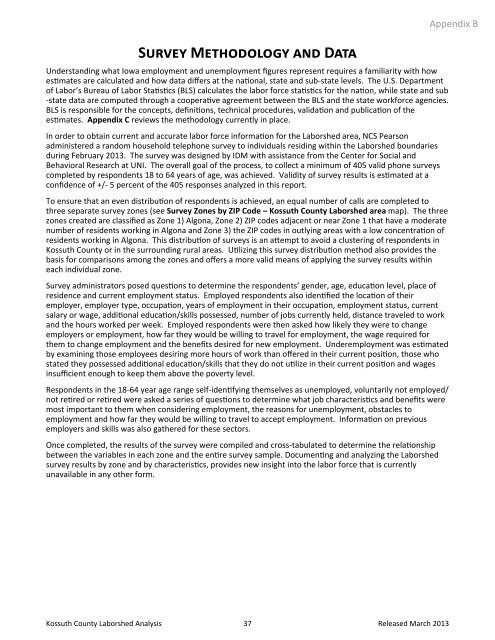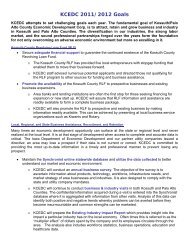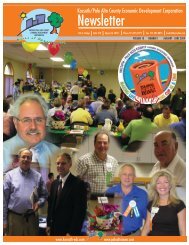Full Report - Kossuth County Economic Development
Full Report - Kossuth County Economic Development
Full Report - Kossuth County Economic Development
You also want an ePaper? Increase the reach of your titles
YUMPU automatically turns print PDFs into web optimized ePapers that Google loves.
S M DUnderstanding what Iowa employment and unemployment figures represent requires a familiarity with howesmates are calculated and how data differs at the naonal, state and sub‐state levels. The U.S. Departmentof Labor’s Bureau of Labor Stascs (BLS) calculates the labor force stascs for the naon, while state and sub‐state data are computed through a cooperave agreement between the BLS and the state workforce agencies.BLS is responsible for the concepts, definions, technical procedures, validaon and publicaon of theesmates. Appendix C reviews the methodology currently in place.In order to obtain current and accurate labor force informaon for the Laborshed area, NCS Pearsonadministered a random household telephone survey to individuals residing within the Laborshed boundariesduring February 2013. The survey was designed by IDM with assistance from the Center for Social andBehavioral Research at UNI. The overall goal of the process, to collect a minimum of 405 valid phone surveyscompleted by respondents 18 to 64 years of age, was achieved. Validity of survey results is esmated at aconfidence of +/‐ 5 percent of the 405 responses analyzed in this report.To ensure that an even distribuon of respondents is achieved, an equal number of calls are completed tothree separate survey zones (see Survey Zones by ZIP Code – <strong>Kossuth</strong> <strong>County</strong> Laborshed area map). The threezones created are classified as Zone 1) Algona, Zone 2) ZIP codes adjacent or near Zone 1 that have a moderatenumber of residents working in Algona and Zone 3) the ZIP codes in outlying areas with a low concentraon ofresidents working in Algona. This distribuon of surveys is an aempt to avoid a clustering of respondents in<strong>Kossuth</strong> <strong>County</strong> or in the surrounding rural areas. Ulizing this survey distribuon method also provides thebasis for comparisons among the zones and offers a more valid means of applying the survey results withineach individual zone.Survey administrators posed quesons to determine the respondents’ gender, age, educaon level, place ofresidence and current employment status. Employed respondents also idenfied the locaon of theiremployer, employer type, occupaon, years of employment in their occupaon, employment status, currentsalary or wage, addional educaon/skills possessed, number of jobs currently held, distance traveled to workand the hours worked per week. Employed respondents were then asked how likely they were to changeemployers or employment, how far they would be willing to travel for employment, the wage required forthem to change employment and the benefits desired for new employment. Underemployment was esmatedby examining those employees desiring more hours of work than offered in their current posion, those whostated they possessed addional educaon/skills that they do not ulize in their current posion and wagesinsufficient enough to keep them above the poverty level.Respondents in the 18‐64 year age range self‐idenfying themselves as unemployed, voluntarily not employed/not rered or rered were asked a series of quesons to determine what job characteriscs and benefits weremost important to them when considering employment, the reasons for unemployment, obstacles toemployment and how far they would be willing to travel to accept employment. Informaon on previousemployers and skills was also gathered for these sectors.Once completed, the results of the survey were compiled and cross‐tabulated to determine the relaonshipbetween the variables in each zone and the enre survey sample. Documenng and analyzing the Laborshedsurvey results by zone and by characteriscs, provides new insight into the labor force that is currentlyunavailable in any other form.Appendix B<strong>Kossuth</strong> <strong>County</strong> Laborshed Analysis 37 Released March 2013




